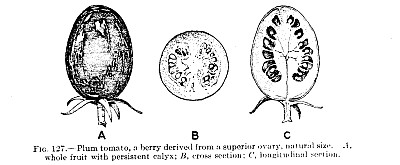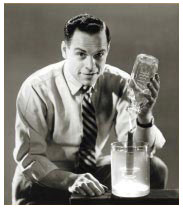Illustrations Figure 1. Cross-sections of a plum tomato from an old botany textbook
illustrates the
Figure 1. Cross-sections of a plum tomato from an old botany textbook
illustrates the cut-it-openscientific approach.  Figure 2. Cross-section of a plant stem, magnified.
Figure 2. Cross-section of a plant stem, magnified.
 Figure 3. Snowflake. Magnification is another way to make the
Figure 3. Snowflake. Magnification is another way to make the
hiddenvisible. (See snowcrystals.com for more such images)  Figure 4. Mr.Wizard (Don Herbert); the most famous TV scientist.
Figure 4. Mr.Wizard (Don Herbert); the most famous TV scientist.
 Figure 5. Product of an engineering effort: the light bulb.
Figure 5. Product of an engineering effort: the light bulb.
 Figure 6. TRW technicians testing a satellite in an anechoic chamber.
Figure 6. TRW technicians testing a satellite in an anechoic chamber.
|
Science BasicsIntroductionThe ostentation implied by the title of this page is granted.
Yet the subject must somehow be dealt with. To go out into this modern
world without some concept of Let's take the word itself. My handy-dandy little college dictionary
tells me that the word came from a Latin word meaning to discern or
distinguish. Its Indo-European base seems to be All sorts of interesting time-worn quotations exist concerning the nature or power of knowledge and truth. They are not time-worn for no reason! You yourself may be able to recall a time when knowing the truth gave you more power in a situation. And so it is said that the knowledge of how to create an atomic explosion helped end World War II. While that assertion might be in question, the power released by the explosions over Hiroshima and Nagasaki certainly is not! The spiritual approach to gaining knowledge is different. It has been described
to me as You may be able to think of examples of how scientists learned more about something by literally cutting it open (anatomy), or blasting it apart (sub-atomic physics). And this is indeed the general approach. This appraoch is in fact so efficatious for so many problems of life that those who feel that they depend on secrecy for their survival are afraid of it and constantly work to arrest its advance. To over-simplify just a bit, that is the current situation. Certain criminal elements in society have succeeded in talking their way into the universities and governments as experts in certain esoteric fields. The best-known and most dangerous of these is psychiatry. Though this group pretends to preside over a legitimate scientific subject, it has been amply demostrated that they in fact do not practice science and in fact practice secrecy. And they have been convincing workers in other fields, particularly allied fields such as politics, psychology, public relations, advertising, warfare, and intelligence gathering to operate in a similar manner. Of course, if essential facts and findings are hidden in order to permit criminal acts to occur, then to that extent science cannot progress as it should. Its central modus operandi is uncovering hidden secrets. If sufficiently subverted, all you have left is a kind of secular priesthood. This is not good for truth, and not good for humanity. And so I submit to you that the above are the basics of science. If you feel a bit cheated I don't blame you. Next I present what I consider to be some of the more important findings of science.
Findings of ScienceMathematics In the sciences, and particularly the physical sciences, prediction is a major goal. An assumption, or observation, is made that certain things seem to be fairly predictable, such as the number of days in a year. If the item being studied seems to behave fairly predictably, its behavior can be modeled by a mathematical function (or similar rule) and thereafter its behavior can be predicted using this model. Mathematical models might be said to take two major forms: continuous and discrete. Continuous models mirror how most of us experience life; as a continuous flow of events with no odd gaps. Discrete models are normally considered to be approximations of reality. They work with sets of discrete points, values, or measurements. If the distance between the points is not too great compared to the behavior being modeled, then the discrete model is workable. As the distance between the data points of a discrete model reduces, it looks more and more like a continuous model. With the rise of computers, discrete models of reality have come into wide use. A “JPEG” image is an example. On the other end of the scale, physics has discovered behavior, such as quanta, that seem to favor the use of discrete models in systems normally thought of as continuous. The concept that physical reality has inherent discontinuities that cannot be accurately predicted (but that in most circumstances can be ignored) is an important part of “modern” physics. E=Mc² This now-ubiquitous equation, credited to Einstein if I am not mistaken, is a very simple mathematical formula for predicting the total amount of energy contained in a piece of matter. It takes only one characteristic of that matter into consideration, its mass. The value “c” is said to be a constant, though that is debated. It represents the velocity of light propagation in a vacuum. The major interest in this equation is in its implications. If matter can be transformed into energy, in a fission or fusion reaction for example, then couldn’t energy likewise be transformed into matter? Doesn’t it follow, then, that matter and energy are just two different forms of basically the same thing? An analogy is that ice, water and steam are all basically still water, just in different states. If you add heat to matter it eventually will change state. Is there some property of matter, which, if you added or removed it, would change matter into pure energy? The presumption is that there is, and my guess is that it is basically the property of matter which we call “gravity.” Have you ever known an energy form that could exert gravitational pull? Gravity is a property of mass. Turn mass into energy and it loses its gravity. Add gravity to energy and it becomes matter. Quantum mechanics Since people have been able to observe light spectra, it has been noticed that the spectra of pure elements (as well as many compounds) are discontinuous. A matter-energy exchange method had already been worked out, which seemed to predict chemical behavior with great accuracy. This had to do with the theoretical behavior of electrons. Exposing matter to an energy source would result in a certain amount of that energy “going into” the matter. The matter might get hotter, or it might start glowing or doing something else similar. The theory was that the electrons in the matter were responsible for this. That they could absorb energy and that they could also radiate it back out. The discrete lines of most spectra indicated that these electrons were “jumping” back and forth between distinct energy states. One way to model this mathematically was to think of energy as made up of zero-mass particles. This energy “particle” could then hit, or interact with, an electron which would result in the electron jumping up to a higher energy level. When it fell back to a lower level, it would radiate the energy back out, either as the same type of energy particle that it initially received, or as two or more energy particles that, when added together would equal the amount of energy originally received. The above is now the theoretical basis for all phenomena regarding the absorption and emission of radiated energy in matter. It does not particularly address the energy contained in the heavier atomic particles (classically, protons and neutrons). This phenomenon has been taken advantage of to produce the now-ubiquitous light-emitting diode (LED) first used to replace the old neon power indicators and now being ramped up into a fully-functional replacement for incandescent, fluorescent, and controlled-plasma lighting. Lasers operate on the same principle, with the addition of one or more resonant cavities. Germ theory Medicine, still considered on the level of witchcraft by many, made a huge leap forward when it discovered the “germ theory” of disease. This opened up a huge are of research for medicine that is still very much being pursued. There remains, however, the nagging problem of chronic illness. And in this field the old witchdoctors had a better grasp of what was really going on than do the medical scientists of today. There has been voluminous work done, in modern times, on spiritual causes of non-optimum body conditions. But this has largely been ignored, except to admit the psychological factor of “stress” into the equation. Medicine, dealing as it does with real people, will not come into full bloom until it embraces all workable knowledge that has been developed about how real people relate to their bodies. A similar comment could be made about all the social sciences, which I have otherwise not mentioned here. DNA In the field of biology, which currently underlies most of modern medicine, the discovery of DNA, which began with studies in genetics, has to be the biggest milestone. This gives a chemically-based (thus tying it tightly to the physical sciences) method for the replication of complex traits from generation to generation from a cellular level all the way up to full organisms. The technology then developed to discover genetic “codes” welded biology to the subject of Information Technology. This has the potential for blasting traditional views of the origins of life totally out of the water. It very strongly suggests that life forms result from intelligent design (which has been a matter of legend on earth since before the Great Flood) and brings into question all the materialist explanations for the origin of life forms. Currently, most scientists are not pushing in these new directions. Instead, many are still trying to convince us that the very manner in which we think and feel is coded into our genes, and that these codes are actually the result of a concatenation of happy accidents. That is such a line of tripe! But I digress. The above is a very brief summation of some of the most important findings of modern science (from my viewpoint) more or less using the vocabulary of modern science. But, hey – all I do is read stuff. Some of this material could have mistakes in it, so remember to check it out for yourself and come to your own conclusions. The findings of other studies are presented on other pages in this site.
ResourcesGeneralIt has been difficult for me to find details on specific scientific subjects
and advances. A large part of the literature is controlled by the professional
journals, and most of these require about $20 for a pdf download of an article.
Science Basics |